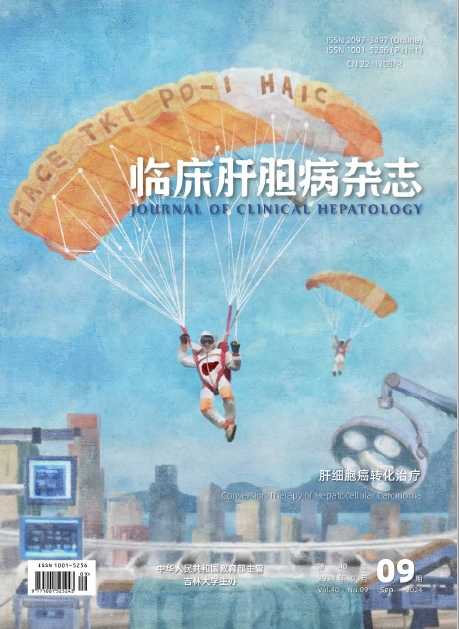| [1] |
HAN BF, ZHENG RS, ZENG HM, et al. Cancer incidence and mortality in China, 2022[J]. J Natl Cancer Cent, 2024, 4( 1): 47- 53. DOI: 10.1016/j.jncc.2024.01.006. |
| [2] |
ZHANG BH, DONG W, LUO HP, et al. Surgical treatment of hepato-pancreato-biliary disease in China: The Tongji experience[J]. Sci China Life Sci, 2016, 59( 10): 995- 1005. DOI: 10.1007/s11427-016-5104-8. |
| [3] |
LLOVET JM, RICCI S, MAZZAFERRO V, et al. Sorafenib in advanced hepatocellular carcinoma[J]. N Engl J Med, 2008, 359( 4): 378- 390. DOI: 10.1056/NEJMoa0708857. |
| [4] |
CHENG AL, KANG YK, CHEN ZD, et al. Efficacy and safety of sorafenib in patients in the Asia-Pacific region with advanced hepatocellular carcinoma: A phase III randomised, double-blind, placebo-controlled trial[J]. Lancet Oncol, 2009, 10( 1): 25- 34. DOI: 10.1016/S1470-2045(08)70285-7. |
| [5] |
CHENG AL, QIN S, IKEDA M, et al. Updated efficacy and safety data from IMbrave150: Atezolizumab plus bevacizumab vs. sorafenib for unresectable hepatocellular carcinoma[J]. J Hepatol, 2022, 76( 4): 862- 873. DOI: 10.1016/j.jhep.2021.11.030. |
| [6] |
LENCIONI R, KUDO M, ERINJERI J, et al. EMERALD-1: A phase 3, randomized, placebo-controlled study of transarterial chemoembolization combined with durvalumab with or without bevacizumab in participants with unresectable hepatocellular carcinoma eligible for embolization[J]. J Clin Oncol, 2024, 42( 3_suppl): LBA432. DOI: 10.1200/jco.2024.42.3_suppl.lba432. |
| [7] |
ZHAO HT, SANG XT, RUI JA, et al. Analysis of curative effect of unresectable advanced liver cancer resection after descending stage[J]. Acta Acad Med Sin, 2009, 31( 4): 503- 505. DOI: 10.3881/j.issn.1000-503X.2009.04.024. |
| [8] |
YU YQ, TANG ZY, ZHOU XD, et al. Treatment of large hepatocellular carcinoma by stages[J]. Chin J Surg, 1983, 21( 2): 92- 93.
余业勤, 汤钊猷, 周信达, 等. 大肝癌的分阶段治疗[J]. 中华外科杂志, 1983, 21( 2): 92- 93.
|
| [9] |
CHEN H, WU MC, ZHANG XH. Two-stage resection of primary liver cancer: a report of 9 cases[J]. J Pract Surg, 1988, 8( 10): 529- 530.
陈汉, 吴孟超, 张晓华. 二期手术切除原发性肝癌九例报告[J]. 实用外科杂志, 1988, 8( 10): 529- 530.
|
| [10] |
National Health Commission of the People's Republic of China. Standard for diagnosis and treatment of primary liver cancer(2024 edition)[J]. J Clin Hepatol, 2024, 40( 5): 893- 918. DOI: 10.12449/JCH240508. 中华人民共和国国家卫生健康委员会. 原发性肝癌诊疗指南(2024年版)[J]. 临床肝胆病杂志, 2024, 40( 5): 893- 918. DOI: 10.12449/JCH240508. |
| [11] |
WANG Z, REN ZG, CHEN Y, et al. Adjuvant transarterial chemoembolization for HBV-related hepatocellular carcinoma after resection: A randomized controlled study[J]. Clin Cancer Res, 2018, 24( 9): 2074- 2081. DOI: 10.1158/1078-0432.CCR-17-2899. |
| [12] |
WEI W, JIAN PE, LI SH, et al. Adjuvant transcatheter arterial chemoembolization after curative resection for hepatocellular carcinoma patients with solitary tumor and microvascular invasion: A randomized clinical trial of efficacy and safety[J]. Cancer Commun, 2018, 38( 1): 61. DOI: 10.1186/s40880-018-0331-y. |
| [13] |
QIN SK, CHEN MS, CHENG AL, et al. Atezolizumab plus bevacizumab versus active surveillance in patients with resected or ablated high-risk hepatocellular carcinoma(IMbrave050): A randomised, open-label, multicentre, phase 3 trial[J]. Lancet, 2023, 402( 10415): 1835- 1847. DOI: 10.1016/S0140-6736(23)01796-8. |
| [14] |
LI BK, WANG CW, HE W, et al. Watch-and-wait strategy vs. resection in patients with radiologic complete response after conversion therapy for initially unresectable hepatocellular carcinoma: A propensity score-matching comparative study[J]. Int J Surg, 2024, 110( 5): 2545- 2555. DOI: 10.1097/JS9.0000000000001155. |







 DownLoad:
DownLoad: